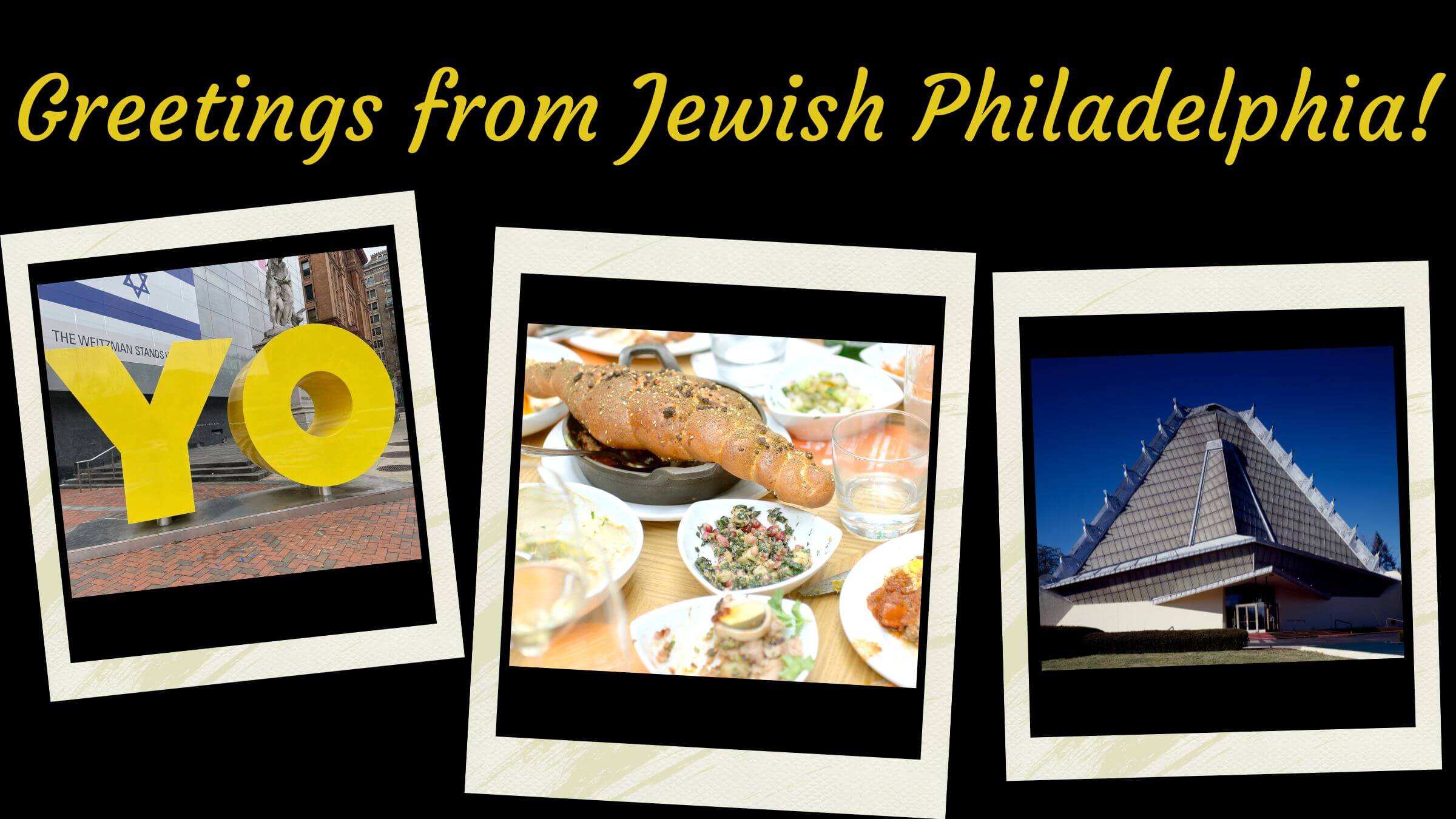Debate city: What’s so Jewish about Philadelphia, site of Harris-Trump matchup?
Jewish museums and history, large Jewish population and renowned Israeli chef

From left to right, “OY/YO” sculpture at Weitzman Museum; food prepared by Michael Solomonov; synagogue designed by Frank Lloyd Wright. Photo by Julie Moos (sculpture); Getty (food); Buyenlarge/Getty (synagogue)
Philadelphia, the site of Tuesday night’s debate between Vice President Kamala Harris and former President Donald Trump, has been central to U.S. politics since the 18th century, when the Founding Fathers met there to sign the Declaration of Independence and write the U.S. Constitution.
This is a topic I have covered in the past, but I regret to inform you, in case you didn’t already know, that none of these folks were Jewish.
But since you’re reading this story in the Forward, I’ve put together a Jewish tour of Philadelphia. While members of the tribe weren’t headliners in Philly’s presidential past, the city has a long and robust Jewish history, and Jews have a vibrant presence there today. According to a 2020 Jewish Federation survey, the five-county Philadelphia region is home to 350,000 Jews, one of the largest Jewish populations in the U.S..
And not for nothing, the city is located in a critical swing state for the presidential election. Pennsylvania is being targeted by the Republican Jewish Coalition as part of a $10 million ad campaign in those seven battleground states.
Here are some highlights of Jewish Philly.
Museums and synagogues
The Weitzman National Museum of American Jewish History is located on Independence Mall, across from the Liberty Bell in the heart of Philadelphia’s Historic District. It’s also two blocks from the National Constitution Center, site of Tuesday’s debate. Exhibits at the Weitzman include artifacts from the hostage-taking at the Colleyville, Texas, synagogue; Deborah Kass’ famous bright yellow OY/YO sculpture (the original iteration of the iconic piece is located outside New York’s Brooklyn Museum); and artifacts related to Jewish history in the New World, starting with Sephardic Jews from Brazil who settled in New York in the 16th century.
Congregation Mikveh Israel, known as the “Synagogue of the American Revolution,” located near the Weitzman Museum, is one of the country’s oldest congregations. It dates its roots to 1740, when Nathan Levy, a merchant and Philadelphia’s first Jewish resident, sought permission from authorities to bury his child in keeping with Jewish ritual. That gravesite was the first burial plot in what became a Jewish cemetery and the start of Philadelphia’s Jewish communal life.
Elkins Park, a Philly suburb, is home to the only synagogue ever designed by Frank Lloyd Wright. Beth Sholom Synagogue was built after its rabbi, Mortimer J. Cohen, wrote to Wright, inviting him to create a modern building for the congregation. The structure has no windows and gets natural light through a glass roof and rotunda.
For Jewish sports fanatics, there’s the Philadelphia Jewish Sports Hall of Fame and the prideful knowledge that MLB’s Philadelphia Phillies’ roster includes Max Lazar, a Jewish pitcher, and Garrett Stubbs, a Jewish catcher. The pair were part of a rare alignment of Jewish players in August when they played the Arizona Diamondbacks. The Diamondbacks’ Joc Pederson, a Jewish hitter, faced the Jewish pitcher and Jewish catcher — and struck out.
A famous chef and famous alumni
One of Philly’s most renowned chefs, Israeli-born Michael Solomonov, has won five James Beard awards, including for cookbook of the year, outstanding chef and outstanding restaurant for Zahav, which was the first Israeli restaurant to win a Beard. The chef owns a number of other eateries, including the kosher falafel chain Goldie, which was targeted by pro-Palestinian activists protesting the Israel-Hamas war. Solomonov’s brother was killed in 2003 while serving in the IDF.
Also targeted by vandals: Philly’s Holocaust Memorial Plaza, which was defaced in January with a swastika.
Famous Jewish alumni from the Philly area include Benjamin Netanyahu, who attended Cheltenham High School, a public high school in a suburb about 13 miles outside of the city. His father moved the family there in 1963, but according to the JTA, Netanyahu felt “little attachment to the school or town. He didn’t even stay for the graduation ceremony — leaving to join the Israeli Defense Forces for the Six-Day War in June 1967.”
Graduates of Philadelphia’s Akiba Hebrew Academy include CNN’s Jake Tapper, bestselling author Mitch Albom, Rabbi David Wolpe and Pennsylvania Gov. Josh Shapiro and his wife, Lori.
Correction: An earlier version of this story misspelled the name of the Weitzman National Museum of American Jewish History and incorrectly stated that Solomonov’s brother was killed in the Yom Kippur War. He was killed on Yom Kippur in 2003.
A message from our CEO & publisher Rachel Fishman Feddersen
I hope you appreciated this article. Before you go, I’d like to ask you to please support the Forward’s award-winning, nonprofit journalism during this critical time.
We’ve set a goal to raise $260,000 by December 31. That’s an ambitious goal, but one that will give us the resources we need to invest in the high quality news, opinion, analysis and cultural coverage that isn’t available anywhere else.
If you feel inspired to make an impact, now is the time to give something back. Join us as a member at your most generous level.
— Rachel Fishman Feddersen, Publisher and CEO